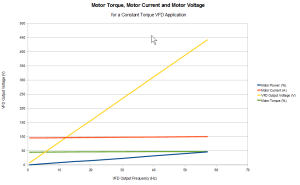Following up on a previous post about the few important formulae when applying variable frequency drives specifically to ac induction motors, this post will get into the topic of constant torque variable frequency drive applications.

What is a constant torque application? Constant torque applications may have close to a uniform torque requirement across the motor speed range. The bigger consideration from the perspective of drive selection is that these applications will require relatively high torque at low speeds compared to a pump or fan.
The actual requirement arises from the load attached to the motor. For example a connveyor may need to exert significant torque at low speeds if there are objects already on it. Another example is a progressive cavity pump which relies on positive displacement to move fluid.
Why is it important to distinguish the requirements of constant torque applications ( versus variable torque)?
1. Higher torque at lower speed requires better speed regulation capabilities within the drive. Without speed feedback from the motor, drives rely on electrical feedback in the form of current and voltage as well as phase angle vector analysis between the two to regulate the speed loop. For example, if speed drops, the drive will have to increase voltage through its IGBT gating control on the output to effect a speed increase. This determination is made continously and rapidly and in both directions ( to increase or decrease output voltage) to maintain a speed setpoint.
2. Higher torque at lower speed requires for the drive to handle higher current draw at low speed.
If torque is the same throughout – what happens to voltage and current throughout the speed range?
This is where reverting to the motor torque formula is useful.
Observations based on this formula are:
1. If torque stays the same ( constant torque) and the VFD output frequency (and motor speed) is increasing between 0-60Hz, horsepower or motor power consumption has to increase.
2. Motor power is going to be made up of two components of interest to us here ( assuming power factor and efficiency are constant) and they are voltage and current. Torque is proportional to current which infers that current will not change ( much). That leaves a variance in voltage, which also happens to be the component that the drive can alter with its voltage source inverter nature.
Some variance does occur in motor current. One possible reason is that motor impedance characteristics are affected by frequency- this is a topic of its own.
The graph at the top of this post shows the motor torque, motor voltage and motor current across the speed range. The load torque required in this example case is about 50%.
